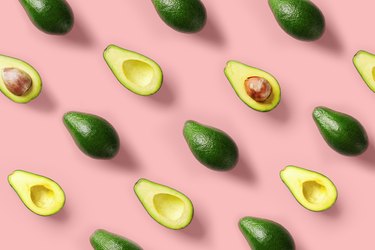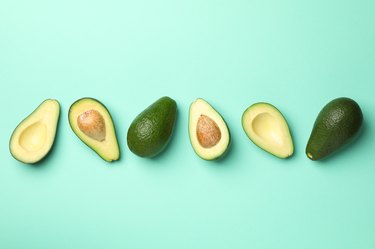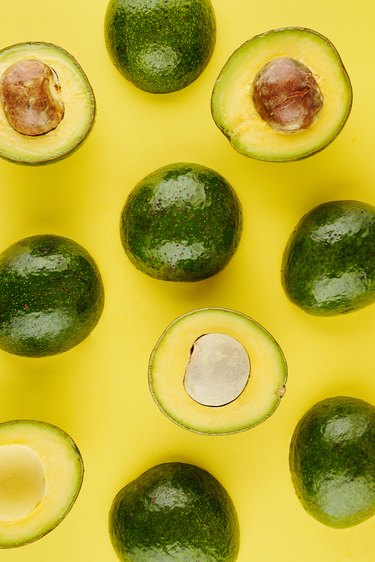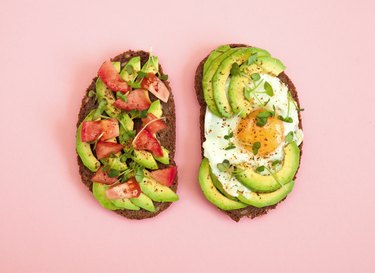
There are some ingredients that bring a hint of everyday luxury to your kitchen, and the versatile avocado is one of them. Avocados are indispensable on toast or in salads, in wraps, on sandwiches or tacos and—of course—in the form of guacamole.
Though they're no longer rare, avocados are still the source of confusion for some home cooks. If you're in that camp (love 'em but don't really understand 'em), sit back and grab a bowl of chips. We'll tell you what you need to know about avocados to help you reach expert status and handle your avocados with ease!
Video of the Day
Video of the Day
Where do avocados come from?

According to the Agricultural Marketing Resource Center, California accounts for the majority of domestic avocado production, while Florida chips in with most of the rest. You'll find California avocados at the supermarket from spring through autumn, with avocados from Florida, Mexico and the Dominican Republic arriving later in the summer and lasting into winter. For the rest of the year, other sources—notably Peru and Chile—pick up the slack. Orchards in the southern hemisphere produce while those in the northern hemisphere reload for a new season, which is why you get to enjoy avocados year-round!
Which avocado varieties are sold in stores?
The most common avocado you'll see in American supermarkets is the Hass variety. There are thousands of other named varieties out there, but only a handful are sold in stores. These are the Bacon, Gwen, Zutano, Fuerte, Pinkerton and Reed avocados. They all have distinctive characteristics (Reed, for example, is jumbo-sized, round and extra-fleshy), but none match the Hass for sheer popularity.
Where Did Hass Avocados Get Their Name?
Hass avocados are named after a postman (Rudolph Hass) who found a really good avocado on his route, cloned it and created an orchard that’s still producing today. Talk about a fun origin story!
You might also sometimes see small, slender fruit marketed as "finger" or "cocktail" avocados, which aren't actually a separate variety at all. When an avocado blossom isn't properly pollinated, the resulting fruit remains slim instead of plumping out in the typical fashion. Growers call them "cukes" because of their resemblance to pickling cucumbers. Marketing them as a specialty item is a recent development, because...well, why not? They're still tasty and perfectly snack-sized.
How do I choose a good avocado?

Avocados are green and hard when they come from the tree. And in fact—unlike many fruits—they can't actually ripen until after they've been picked. Most avocados (but not all) darken as they ripen, which provides a useful visual cue. Ultimately, though, the best test is physical. Pick up an avocado that looks like it's ripe and give it a gentle whole-hand squeeze; a ripe avocado will have a little bit of "give," while an unripe avocado will be hard. Don't pinch it with a thumb and finger. That just causes bruising.
Finding avocados at the supermarket that are ripe and ready to use is a gamble, so your best bet is to buy them a few days ahead of time and let them ripen on your counter. If you're in a hurry, you can put the avocados in a paper bag to capture the natural ethylene gas they produce and speed ripening (adding an apple or banana to the bag will make the process even faster). Again, use the squeeze test to check for ripeness. You can also remove the little stub of stem at the top of the avocado and look at the flesh underneath. If it's that perfect "avocado green," you're good to go. Otherwise, let it sit for another day. (If it's dark, you've already missed your window.)
If you cut into an avocado and find that it's not quite ready, turn to a couple of popular avocado hacks. Some cooks soften avocado by microwaving it gently and briefly, which makes it easier to mash or slice. It won't have the rich fattiness of a properly ripened avo, but you can cheat by adding a splash of good olive oil to make up the difference. If the avocado is overripe and starting to darken 0r get stringy, you can still scoop out any portions that have the right color and discard the rest.
How should I store avocados?

While you're waiting for avocados to reach peak ripeness, they should stay out on the counter at room temperature. This is because refrigeration slows the ripening process to a near-standstill. From that, you can guess that putting any leftover avocados in the fridge once they've fully ripened is a good way to extend their usable life (very handy if you've bought a bag or a flat of avocados and they're now ripening faster than you can use them).
A cut avocado should always be refrigerated to keep it from deteriorating due to oxidation (we'll come back to that in a minute), and so should any guac or other prepared avocado dishes you aren't going to eat right away.
How should I cut and slice an avocado?
Start by halving the avocado along its longer side. You can do this while holding it if you're confident in your knife skills, but it's safer to slice on a counter or cutting board. With a sharp knife, cut horizontally into the avocado until your blade hits the pit, then rotate the fruit to cut it all the way around. Pick up the avocado and give it a twist. The two avocado halves should separate neatly in your hand. One will have the pit in it, which you can pry out with your fingers or scoop out with a spoon.
Then there's the question of how to slice and scoop the avocado's flesh from its skin. There are specialized avocado slicers, usually made of durable hard plastic, that have a rounded outer edge to scoop the flesh from its skin and spoke-like inner blades to slice it simultaneously. If you eat a lot of avocados, it's not a bad idea to have one. Otherwise, there are two common techniques. One is to carefully slice the avocado half, without breaking its skin, and use a large spoon to scoop out pre-sliced flesh. The other reverses that process, scooping out the avocado first onto a cutting board, then slicing it. Both techniques work, so it's just a question of which one feels more comfortable.
Does the pit really keep an avocado from turning brown?

If you're using only one avocado half at a time, you're faced with the question of how to store the second half. Unfortunately, like many fruits, cut avocados turn brown. There's a persistent piece of lore that says leaving the pit in the unused half will slow or stop the browning process. It would be nice to believe that's true, but it simply doesn't hold up under controlled testing.
The browning reaction is caused by oxygen exposure at the cut surface of the avocado. There's an enzyme in avocados called polyphenol oxidase that reacts with oxygen to turn avocado flesh brown and mushy, and the pit provides no countermeasure to stop it. Except for the avocado portion that's actually underneath the pit and neatly sealed from the outside air, it won't make a difference.
How do I stop avocados from browning?
There are several factors that can slow this oxidative browning to a crawl. One is simply exposure to cold, which is why you should always put cut avocados in the fridge. Another very useful tool—logically enough when you want to stop oxidation—is to use common antioxidants to protect avocados. These include acidic liquids like lemon juice and lime juice or powdered antioxidants like citric acid or ascorbic acid. Citric acid is the powder sold in your produce section under various brand names, while ascorbic acid is simply vitamin C.
Dissolve either a crushed vitamin C tablet or a pouch of citric acid into a bit of water and brush it onto the cut side of your avocado to prevent browning. You can do the same with lemon or lime juice by simply squirting some onto your avo or diluting it with water and brushing it on.
A third way to prevent oxidation is simply keeping oxygen away from the cut surface of the avocado. You can do this for a half section by wrapping exposed flesh snugly in plastic wrap or for guacamole by placing it in an airtight container (ideally with plastic wrap pressed against the actual surface of the guac, because nobody likes brown guacamole). You can even put your half-avocado in a container, cut side down, then add enough water to submerge the avocado to about a quarter-inch. The water provides an airtight seal and prevents browning.
How good are frozen or vacuum-packed avocados?

There will be times when you want to make one of your favorite avocado recipes but your local stores can't oblige with a fresh avocado that's usable. Rather than doing your best with an unripe avocado or trying to make up a whole avocado by scooping the good parts from several overripe ones, you might be better off keeping a convenience-packaged avocado option on hand. Depending where you live, you will almost certainly have access to either frozen diced avocado pieces or vacuum-packed fresh avocado halves.
Frozen avocado chunks are generally treated with citric acid to prevent browning, so they'll have an odd tang to them that some people don't care for. That means they're best in guacamole or other settings where there'll be enough going on to mask any slight oddities of flavor or texture. Vacuum-packed avocados are better, if you have access to them, and keep their green color surprisingly well. This is the option you'll want for avocado toast, salads or anywhere else that the avocado will be front and center.
And there you have it: everything you need to know to step up your avocado game. The next time you use avocados in a recipe, you'll feel like a seasoned pro. Guac for all!
